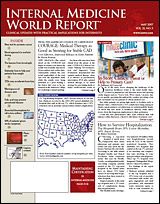Publication
Article
Internal Medicine World Report
How Much Should Society Pay for 1 Year of Life Saved?
Author(s):
Controversies in Metastatic Prostate Cancer Therapy
ORLANDO—At a provocative lecture titled “Diagnosis and Treatment of Men with Prostate Cancer: Can We Afford the Future?” held at the annual Prostate Cancer Symposium sponsored by the American Society of Clinical Oncology, Thomas J. Smith, MD, suggested that the answer is no, asking the audience, “Please, don’t shoot the messenger.”
Whether it is the high cost of drugs and high-tech equipment or physicians’ salaries, Dr Smith, of the Virginia Commonwealth University Health System, Richmond, says that cancer care, especially for metastatic cancer, is expensive, and we need to come up with ways to more appropriately allocate available resources.
IMWR
He tells that he has “tried to create networks of providers that can offer great care at reduced cost, thus freeing up more money for medically appropriate care. Right now, we spend about 16% of our gross domestic product on medical expenses. Thirty years ago, we spent 6% on healthcare and 6% on education. Now, we are spending 16% on healthcare and only 7% on education.”
As examples of expensive and unnecessary procedures, he notes that 24% of Medicare patients receive chemotherapy in the last 2 weeks of their life, even though the likelihood that it will help patients with such an advanced disease state is minute. Sometimes, indeed, it is the patients who request the chemotherapy, but this is mostly because “they don’t get any truthful prognostic and effectiveness information from their cancer doctors.”
How much should society pay for 1 year of life saved? The United States spends twice as much as Australia, Canada, and Japan on healthcare costs per person, with no better quality or quantity of life, Dr Smith says.
Cancer Epidemiol Biomarkers Prev
And the Prostate Cancer Prevention Trial demonstrated that chemoprevention with finasteride (Proscar) gains 13.7 life-years per 1000 men, or 5 days for the average 50-year-old, at a cost of $704,000 per life-year saved (. 2006; 15: 1485-1489). This is well above established thresholds.
How can we control healthcare costs? Dr Smith sees only limited options, such as:
• Reducing the services provided
• Increasing copays
• Establishing standard practices
• Limiting types of chemotherapy and diagnostic tests
• Lowering the cost per service
• Paying physicians less
• Reducing drug costs.
We must look at everything from a societal viewpoint, he says, since these are societal dollars, and all dollars and technologies must be on the table, with no sacred cows.
“One of the solutions is to be honest and upfront about how much things cost, then try to educate patients about what their choices are for therapy. Be honest and realistic to think about how much benefit they get from screening, how much benefit they get from prevention, how much benefit they actually get from palliative chemotherapy, radiation therapy, or the addition of new and expensive drugs,” Dr Smith insists.
“Once we recognize that, we can try to figure out ways to reduce the costs—not with the goal of just reducing the costs but trying to marshal our resources most appropriately so that we could help the most people in the best fashion. The easy targets will be the cost of drugs, the cost of diagnostics, particularly scans, such as CT scans,” he adds.
Dr Smith offers this sobering thought: “No one with metastatic prostate cancer is cured by chemotherapy. The goal of treatment is to make you live some time longer, and to help with your symptoms. There is nothing wrong with this goal. We just have to be realistic about it, and how much we are willing to spend.”





